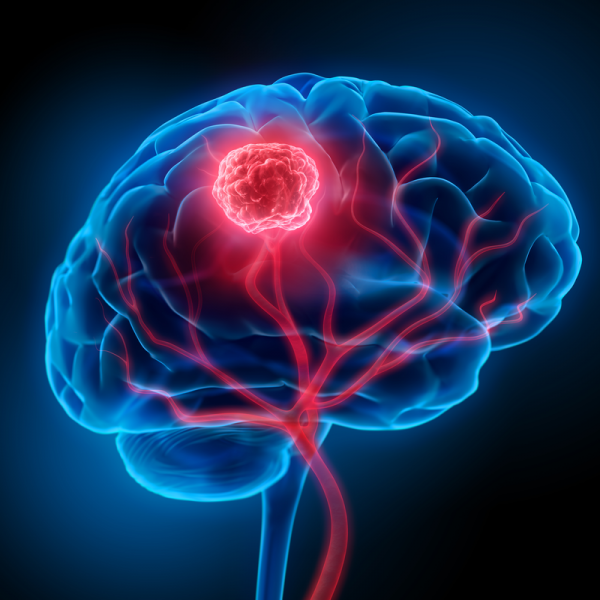
What is a benign brain tumour?
A benign brain tumour describes a disease of the central nervous system. The causes of this disease are still unclear, but it is rather rare compared to other cancers, except in children - where a brain tumour is the second most common type of tumour. A benign brain tumour can affect people of all ages, although serious cases can occur especially in childhood or in older people. In addition to surgery, benign brain tumours can also be treated with radiation therapy or chemotherapy.
What form does a benign brain tumour belong to?
A benign brain tumour belongs to the so-called primary brain tumours, which develop directly from the meninges or the cells of the brain substance. Doctors also call this form of brain tumour the brain's own tumour. With regard to a primary brain tumour, a distinction is also made as to whether the tumour originates in the central nervous system, i.e. the brain and spinal cord, or in the peripheral nervous system. The latter is the case, for example, with a tumour that originates from a cranial nerve.
The WHO has further subdivided the individual tumours of a brain tumour into the respective tissue types:
- Ependymoma: forms from the cells lining the inner chambers of the brain.
- Glioma: derives from the supporting cells of the central nervous system, for example an astrocytoma, an oligodendroglioma or a glioblastoma.
- Meningioma: develops from the meninges.
This subdivision is crucial in the treatment, but also in the prognosis of a brain tumour.
What causes a brain tumour?
The causes of the development of primary brain tumours are still largely unknown. If no trigger for the tumour can be found in the affected person, doctors speak of a sporadic brain tumour. A sporadic brain tumour must be distinguished from brain tumours that have genetic causes. Brain tumours can develop due to certain hereditary diseases such as neurofibromatosis, tuberous sclerosis, von Hippel-Lindau syndrome or Li-Fraumeni syndrome. However, these hereditary diseases are extremely rare and only a few brain tumours can be traced back to them.
What are the symptoms of a brain tumour?
A brain tumour often manifests itself through headaches, nausea and/or vomiting. But sensory disturbances and/or seizures are also not uncommon for a brain tumour. In the early stages, those affected often suffer from rather unspecific symptoms. As the tumour grows, the existing symptoms intensify and new ones are even added, which can vary depending on the location. The majority of all patients frequently complain of the following symptoms:
- Visual disturbances, such as a black spot (visual field loss) or a doubling of images,
- Paralysis, numbness of individual limbs, speech disorders,
- hormonal disturbances,
- Impairment of memory,
- psychological effects, such as depressive states or feelings of anxiety,
- Personality changes
How is a brain tumour diagnosed?
If a brain tumour is suspected, you should consult a specialist in neurology. During a detailed anamnesis, he will first ask about your symptoms and your medical history. He will then begin with the neurological examination, during which muscle reflexes, as well as muscle strength and coordination, will be tested. Furthermore, the function of the cranial nerves is checked. Here, it is tested whether the patient can frown. It is also possible to illuminate the eyes in order to check the pupillary reflex.
In addition to these tests, other imaging procedures such as computer tomography (CT) and/or magnetic resonance imaging (MRI) are also used. An electroencephalography (EEG) and/or a nerve fluid examination is also possible. If these examinations confirm the suspicion of a brain tumour, the doctor will take a tissue sample (biopsy).
A blood test can also provide information about whether a brain tumour is present. For this purpose, the so-called tumour markers are looked for in the blood values. These are substances that the tumour cells release. A blood test can also detect genetic changes, so-called genetic abnormalities.
How is a brain tumour treated?
The treatment of a brain tumour is tailored to the individual case. The most common treatment procedures include surgery, radiation or chemotherapy. All three treatment methods are adapted to the respective tumour and can also be combined with each other if necessary. The choice of procedure depends particularly on the type of tissue, but also on the cell changes as well as the molecular biological characteristics and the tumour stage.
With an operation, the brain tumour can either be removed completely or reduced in size, for example to relieve the discomfort of cranial pressure. However, surgery can also be used to stop the drainage of the cerebrospinal fluid caused by the tumour. Radiation, on the other hand, aims to specifically destroy the brain tumour cells. For some types of brain tumours, radiotherapy is the only treatment option. Chemotherapy, like radiotherapy, is designed to kill the brain tumour cells or at least stop them from multiplying. Chemotherapy can also be used to reduce the size of a tumour before surgery. Doctors refer to this as neoadjuvant chemotherapy. Adjuvant chemotherapy, on the other hand, is when chemotherapy follows surgical removal of the brain tumour. Its purpose is to kill the remaining tumour cells.
What is the prognosis for a benign brain tumour?
The prognosis depends on the course of the disease, the type of tumour, its location and its stage of development at the time of diagnosis. The severity classification of tumours, which was developed by the WHO, serves as a point of reference. A benign brain tumour belongs to the first stage of development. Due to its relatively slow growth, the benign brain tumour has very good healing prospects.
